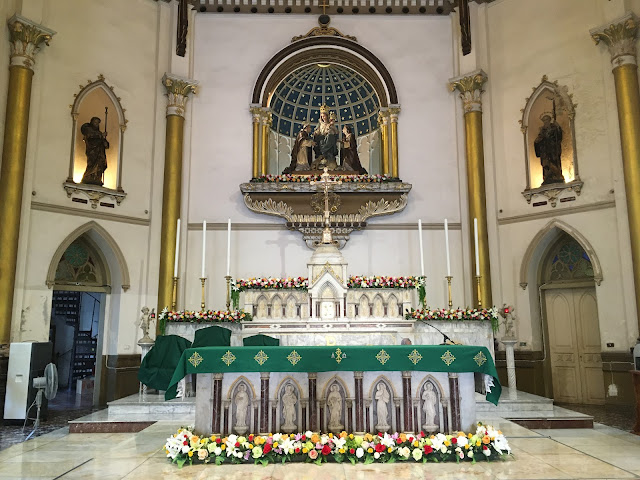Wat Kalawar, or Holy Rosary Church, Bangkok, Thailand
 |
| the altar at Holy Rosary Church in Bangkok, Thailand |
Wat Kalawar, or Holy Rosary Church
the historic Catholic Church in Bangkok's Talad Noi neighborhood
Known in Thai as Kalawar Church - a Thai transliteration of the Portuguese word "Calvario", meaning Calvary or Golgotha; the mount upon which Jesus was crucified - the church arose as a split between two groups of Roman Catholics in Siam. One group of Portuguese expats who fled the destruction of the old Siamese capital of Ayutthaya chose to follow a French priest across the river to Kudi Chin, where the established Santa Cruz Church. The other group established Holy Rosary on the eastern banks of the Chaophraya River in the new capital, Bangkok.
The Thai name of this beautiful Gothic Renaissance church literally means "Cavalry Temple". The honorific "Wat", meaning "Temple" (the same word used in the name of all Buddhist temples in this majority Buddhist kingdom) in Thai is a special distinction granted to some of the city's oldest churches, such as Wat Khmen (The Khmer Temple, or the Church of the Immaculate Conception). Holy Rosary is one of the oldest Catholic Churches in Bangkok.
Located right along the river in the historic Talad Noi neighborhood, the parish at Holy Rosary dates back to 1769, when it was established by Portuguese Catholic merchants and missionaries who had fled Ayutthaya after its fall. The land upon which the church is built was donated by King Rama I of Thailand four years after the establishment of Rattanakosin (today the area of central Bangkok) as the new capital of the kingdom.
By 1838, the Portuguese had gradually moved away and the local Thai-Chinese Catholics had taken responsibility for the maintenance of the parish. A renovation of the Holy Rosary Church was eventually carried out to replace the badly-damaged old building of the previous congregation. In 1890, a French priest - Father Desalles, found that the church was again in disrepair. He arranged for the reconstruction of a new church. It took seven years to complete, as most of the decorations were made and thus had to be imported from France. The "new" church, which is the building that stands to day, was built at that time.
I arrived to visit Holy Rosary Church on a hot and muggy Tuesday morning. It was quiet on the grounds of the historic church. There were no services or mass to be held at that time, and the students of the attached Holy Rosary School were already well into their morning classes.
One of the priests had kindly agreed to show me around inside the historic old church building. Beneath a stained glass window sat a glass coffin containing a statue of a bloody and bandaged Jesus, a venerated artifact dating back over two centuries which is used by the church as a part of its Holy Week observations. This is the Altar to the Dead Christ, a symbol of remembrance to the sacrifice that Jesus Christ made in the redemption of the world. Only infrequently unveiled, this painted wooden statue was imported from Italy, and dates back to the Fall of Ayutthaya. This image of Jesus removed from the crucifix was smuggled out of the burning capital by the Portuguese priests who subsequently fled with it to Bangkok. Today, it is the central image of remembrance during Holy Week.
Another very important artifact at the church is the statue of Mary and the baby Jesus (Madonna and Child), which also dates back to the early days of Roman Catholicism in Thailand. The statue, known as "Our Lady of the Rosary"(the church's namesake), was also taken out of Ayutthaya during the destruction. It is viewed as a miracle that both of these historic images survived the destruction of the old city.
This present church was built in Gothic Revival (neo-Gothic) architectural style. It follows a cruciform floor plan, with the main façade behind a Gothic gable. The church employs Gothic-arched doors and windows throughout, and its stained-glass work is considered to be among the most beautiful in Thailand.
Below the large dome at the back of the church is the altar from where the priest delivers the sermon. Everything in the church was made to order in France and shipped out to Thailand. This includes every statue and all the stained-glass windows which depict the life of Jesus Christ and other biblical stories.
There is something unique, too, about the stained glass. While most stained glass fades over time with heat and sunlight, the special stained glass installed at Holy Rosary Church was treated in Europe in such a way an using secret artisanal techniques so that it actually becomes more beautiful every passing year. The windows in this very special church actually become more vibrant and colorful with the constant exposure to the bright tropical sun.
 |
| stained glass windows at Holy Rosary Church, Bangkok, Thailand |
Other beautiful churches in Bangkok
Visiting Holy Rosary Church in Bangkok, Thailand
Mass is held on Sundays in Thai and Chinese and on weekday evenings in Thai.
Wat Kalawar, or Holy Rosary Church is located in Bangkok at:
You can reach it by public orange flag river boat (depart at River City Pier). It's also an approximately 10-15 minute walk from Hua Lamphong MRT station.
The Wikipedia page of Holy Rosary:
Official website: https://www.facebook.com/profile.php?id=1491211574513184
Bangkok Post writeups:













Comments
Post a Comment